
U.S. President Barack Obama (bottom R) and first family host the 92nd annual National Christmas Tree Lighting on the Ellipse in Washington, Dec. 4, 2014. (Reuters)
It’s a nearly century-old tradition. Every year in December, the U.S. president presides over the lighting of the National Christmas Tree near the White House in Washington, D.C.
The ritual began in 1923–when President Calvin Coolidge lit the first tree on behalf of all Americans–and has remained unbroken since then.
“I think it’s wonderful to have that,” said Lena Ayoub of Maryland. “It symbolizes what we celebrate for Christmas.”
But not everyone agrees. Each holiday season seems to spark a renewed debate over whether it’s appropriate to place religious symbols on public property in a country founded on the principle that a separation of church and state is essential to preserving the rights of all Americans.
“There’s nothing wrong with having a nativity scene at church, or on your private property or in a parade, or some other private venue,” said John Ragosta, a history professor at Oberlin College and author of Religious Freedom: Jefferson’s Legacy, America’s Creed. “But the idea of having government embrace your religion immediately excludes anybody who’s not of your religion.”
The phrase “separation of church and state” appears in an 1802 letter written by Thomas Jefferson, in which he refers to the First Amendment of the US Constitution: “I contemplate with sovereign reverence that act of the whole American people which declared that their legislature should ‘make no law respecting an establishment of religion, or prohibiting the free exercise thereof,’ thus building a wall of separation between Church & State.”
“He was completely supported by 18th century evangelicals, the Baptists, the Presbyterians. They were saying very expressly that this country is not a Christian nation. It is for the Jew, the Gentile, the Hindu, the Mohammedan,” said Ragosta. “These were people who’d been persecuted because church and state had not been separated so they knew exactly what they were talking about.”

The National Menorah, with the National Christmas tree seen behind it, on the Ellipse near the White House in Washington, Dec. 16, 2014. (AP)
In order to reserve that separation, this month the American Civil Liberties Union of the U.S. state of Indiana filed a lawsuit challenging the placement of a religious Nativity scene outside the Franklin County courthouse. The lawsuit alleges the Nativity scene is a violation of the First Amendment because it suggests the county endorses Christianity.
Christians make up about 73 percent of the U.S. adult population, according to figures from 2012. Twenty percent of U.S. adults consider themselves to be unaffiliated with any religion, while about 6 percent identify with non-Christian faiths.
“I think religion is intrinsically part of American culture,” said Gordon Peters of New York, who points to other instances in the United States where the line between government and religion is blurred. For example, American currency bears the words, “In God We Trust”, which has been the official U.S. motto since being signed into law by President Dwight D. Eisenhower in 1956.
“I would prefer to see all religions represented,” Peters said, “but I think it’s part of American culture to have religion be a part of life.”
Since 1979, the National Menorah, a symbol important to the Jewish faith, has joined the National Christmas tree on display near the White House. But what about the public display of symbols that are representative of other religions?
“I don’t have a problem with that,” said Ken Simmons of Houston, Texas. “I think all of the religions should have freedom to express what they feel on the property that they pay the same taxes on as I pay.”
It’s a sentiment shared by his wife, Linda.
“We’ve gotten away from it [public religious displays] because we’re too politically correct,” she said. “I don’t think there’s a problem with it at all and I totally support it.”
A recent Pew Research poll finds 72 percent of U.S. adults believe Christian symbols like nativity scenes should be allowed on government property.
“Religious freedom is not a matter of majority rule,” Ragosta said. “The whole point of religious freedom, and for that matter, freedom of speech, freedom of the press, is to protect the minority view.”

A nativity scene is displayed on the State House grounds in Lansing, Michigan, Dec. 19, 2014, two days before Satanists erected a competing display. (AP Photo)
Roberto Westbrooke, of Norfolk, Virginia, stopped by to see the National Christmas tree during Christmas week.
“Is it endorsing a religion? I haven’t thought much about it, honestly,” he said. “I don’t know but I think they’re opening themselves up to maybe having to have all religions represented there if they want to be…it might get a little odd if there are some satanic worshippers out there.”
There are. As Christmas week got under way in Lansing, Michigan, Christians and Satanists erected competing displays on the grounds of the state capitol, making the question of where to draw the line a complicated one.
“I think if you try to refine to a point, to that tip, you are going to be unsuccessful at being able to display anything that has any sort of religious connotation,” said Lisa from Massachusetts. “What are we comfortable with from a public display perspective? I think you have to look at the culture. I don’t know if there’s really a right or wrong answer but I don’t see that it’s an absolute.”
But Ragosta sees the issue in much more distinct lines, and for him, it brings to mind the motto emblazoned on the official seal of the United States, “E pluribus unum”, meaning, “Out of many, one.”
“If you have a public Christian display and you’re not Christian…if you’re not part of that particular religion, it makes you feel like you’re not part of the government in the same way, you’re not as patriotic, you’re not a part of ‘us’,” he said. “We have many people from many different perspectives, many different religions, many different beliefs, but we’re stronger as one. But a religious symbol on public property divides people, rather than bringing them together.”

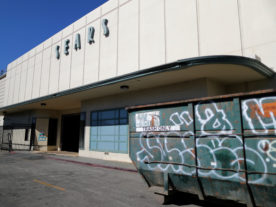
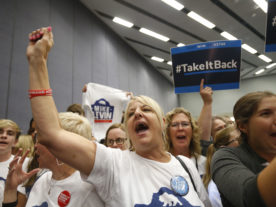
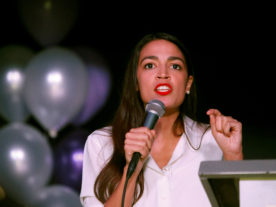

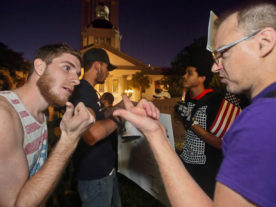

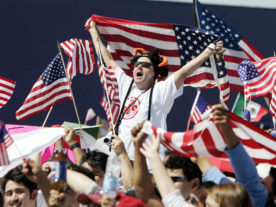
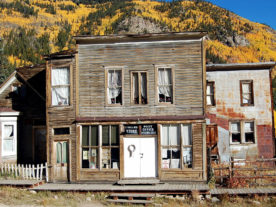
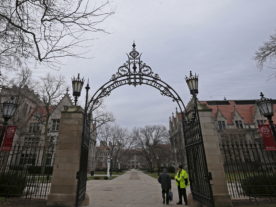

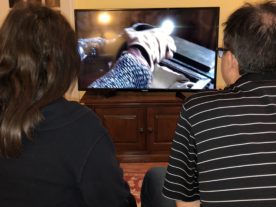





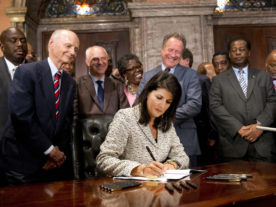

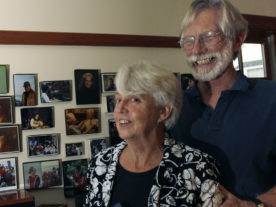


America is possible because of God, for through God everything is possible. You can not take God out of the equation ….for we were created in the image of God. Sorry Dora dear…..you are very wrong in your presumptions ….for yours are based on human reasoning…….which is flawed and corrupted. People divide themselves….not because of God. For we are all one under God. May God Bless you Dora because you are blind to the truth. May God open your eyes and reveal his truth to you.
It is also possible that a free country exists because plain old ordinary human beings who thought about what it meant to be human created this free country. You are hung up on this God thing, but if his book is accurate, he seems to be a nasty demon not a positive being at all. The whole story is sick and twisted. Fortunately, fewer and fewer people are getting sucked into that nastiness. Oh, don’t forget the response that says that once I’m dead I’ll have to face the demon and explain why I didn’t worship it. That’s the bottom line, right? Sad.
You need to go back study the founding of this country and the men responsible for it. Don’t attempt to change history facts that the founders of this country and the men that fought for it were very religious, however, they detested religious persecution. They put the separation of belief and state in the 1st amendment. There is no convenient American history that affirms peoples right of any belief or lack thereof, however, there is the constitution and that is all that is necessary.
I totally agree with you! Merry Christmas everyone and happy holiday!! Let us just enjoy this season of peace and happiness!
nick says:
Perfectly True., Science & Technology has still not been able to DEFY GOD, Who is a Supreme Undisputed Commander
and Controller of this Universe with All these Planets;
USA is believed to be a God Blessed Country because of its Morals = Liberty.Truth & Justice for All =
USA has records of having liberated so many countries from Tyranny & Injustice and is constantly trying to build this world
with Democracy, Liberty, Justice, Truth & Peace
Let’s see, a country blessed by God because of it’s morals? Oh. I guess genocide, deceit, blatant theft, making a hero out of a general who shot down women, children and old people trying to flee his soldiers, all the way up to the waterboarding scandals and setting up a special prison outside of the borders of the country so that the rules of law and order wouldn’t apply to some prisoners, all of these things are examples of American morals which please God. Scares the you-know-what out of me!
I like Christmas very much. Keep the Christmas trees, the candle lighting and especially keep Santa Claus. If politically correct folks need to remove something then remove the religion part of the equation. Its religion that is the point of contention. Christmas trees, candles and Santa Claus actually have nothing to do with the Christian religion at all. I’m not Christian but please wish me merry Christmas, because it is a nice thing to do.
By the way putting other competing religious icons out is a bad thing unless of course they are specific to the season. Can you imagine the response if some one set up a statue of a teen dressed in loose white robes and a suicide vest?
I don’t think there is much difference in religion and Santa Claus. I one is good then he or she gets blessed with gifts. If bad then one gets nothing. I wonder how many kids from poor families who get nothing at Christmas grow up thinking he or she is a bad person.
I grew up without religion in the US, and I’ve always thought it was odd that the country that promises us the most about freedom, and important part of which is separation of church and state, so blatantly and immediately violates their promise with things like this. In school, I was required to say an oath associating God with our country and flag every morning. I had to sit through countless uncomfortable Christian prayers at public school events. Even today, we’ve got God on every piece of money. The question in my mind is this: Sure, maybe it’s just a little thing here and there, but if we can’t even trust our government to do right by their promise with the little things, what chance do we have when an “important” threat to our freedoms comes up?
You had a choice not to recite the pledge of allegiance, you did it because you wanted to fit in; and not to be so blantantly out spoken again’t it as you are now.
Worse, think about how those of us seniors feel when we had to learn the Pledge all over again with changes to the phrasing and all just because some politician had to go pervert it on us. We grew up believing in the separation of Church and State, and here the State was sticking Church into something that belonged to the State. I wasn’t the only one who was disgusted by the whole thing.
“Religious freedom is not a matter of majority rule,” Ragosta said. “The whole point of religious freedom, and for that matter, freedom of speech, freedom of the press, is to protect the minority view.”
This is totally wrong and misunderstood by you. Our founders were forced to mainly observe a Roman Catholic religion that was oppressive and not even remotely sensitive to the true desire God had for people. That drove our founding fathers to America to find a land where they could serve the one and true God. The real reason for “separation of church and state” was so no one in the future would be forced to submit to a religion they didn’t choose. This act was wicked then and would still be considered wicked today. Were you and many others get confused with this wording is because of apparent lack of historical narrative. Our founding fathers were not trying to cripple any religion, but protect the right to practice any religion. When they wrote these words they were thinking of a land that mandated only one religion and if that was not your religion, your religion was against the law. Men and women died for the right to have the freedom to worship the religion they desired. It was not about majority and minority or fairness. It was about a freedom to serve the God you choose.
Your foolish, manipulative and greedy interpretation of this is to force the majority to yield to the unhelpful false religious practices of a few. This is so dumb because it causes the strong to bow down to the weak. This is a cancer that would destroy any great nation. It is not a belief that makes one great.
When a Government personal makes a statement of faith, that is his personal right. To take that away from him is unjust and wicked. A leader is voted in because of who he is and how he makes decisions. To take away the faith and heart of who he is, is like cutting his hand or leg off to serve his country.
You need to think through your opinions and have enough insight to what they lead too. If we don’t like the faith or heart of a leader, we can vote them out. This pattern of thought you have actually corrupts our Government more than helping it. People have to hide what they believe for the sake of political correctness. Political correctness sound great to someone who doesn’t know the mighty love of the God that would do anything for you, but for those who have been saved by Him it is a sad policy that cripples anything that clings to it.
#Romans 5:8, But God demonstrates His own love toward us, in that while we were still sinners, Christ died for us.
I like your comment!
Your history is a little off: the official church of Great Britain was Anglican, not Catholic.
Oops. Europe was run by the Catholic Church and that does include England.
It was Henry VIII who changed all that. He wanted a divorce and especially to keep all his taxes for himself – money that he did not want to send to Rome. He named himself head of the church – the Church of England or the Anglican. The Anglican church service is almost exactly the same as the Catholic. Following Henry’s death there were countless battles between those who wanted to return to the old religion and the new. People were ordered to believe the king’s religion on penalty of death. Lots of folks got heads chopped off.
The real blood bath started when the Bible was translated into the vulgar languages – a blood bath which was further exacerbated by the invention of the printing press. Suddenly everybody and his uncle could invent his own interpretation of the Christianity and slaughter anyone else who disagreed. These were the folks to moved to North American and settled in what is now the US. Their
idea of freedom of religion was a freedom from religious dominance by political interests, however it is important to remember that this freedom applied to WASPs only – Catholics were excluded until 1961 when Kennedy was elect president.
With improvements in education and advancing scientific knowledge church attendance began to fade even in the US, but that all changed with 9/11. Bush declared Islam evil the axis of evil. Christians in the States flocked back to their churches as Bush lead a disastrous crusade against the Moslem world in Iraq.
By the way, I am a atheist and I have a Christmas tree in my home. I don’t need a religion dictating to me how I should remember the central importance of the winter solstice to the ancients.
@Eric Charles Smith says: “Your history is a little off: the official church of Great Britain was Anglican, not Catholic.”
Well, yes it was, but only after it split off from Roman Catholicism during the reign of Henry VIII, when he challenged the authority of Rome and dissolved the Catholic abbeys and monasteries. Elizabeth I formalized “the Church of England,” but the only thing that was different was that the masses that used to be performed in Latin were simplified a bit and done in English . . . dumbed down a bit for the masses . . . but Liz recognized a good thing when she saw one and realized that the real “power over the people” came from the Church, so she took the infrastructure and hierarchy of the all-but-in-name Catholic church and in one fell swoop, created the Church of England and made herself head of the church as well as the head of state. (Small wonder that the writers of the Constitution were very careful to delineate a formal line between church and state).
There’s much more to the story, and much more about the residual influence of the Roman Catholic Church on the Church of England and the now-a-days Anglican Communion, but for all intents and purposes, for the first 250 years or so, there wasn’t all that much difference between the Church of England and the Roman Catholic Church. I was brought up in the Episcopal Church in the US, and even then, I considered it Roman Catholicism lite . . .
Uh, none of the founding fathers of this country were from Europe. That being said, only a few of the colonies had freedom of religion built into them including Maryland which was founded by Catholics. Your view of early American history is rather warped, probably from being in a religion that hates Catholics. Many of the people who were burned at the stake for witchcraft and heresy were burned by the new Protestants, not the Catholics (who did their share as well). As for being forced to follow all the same religion, most of the American Colonies practiced the same thing, usually requiring the Anglican religion to be supported. Go study some objective history, then think about it all.
If England is not a part of the European Continent then where on earth is it?
For a more accurate history of Catholic settlers in Maryland see: carlescarrollhouse.org/learn/catholic-history. Its a short article that deals with the history of one family’s experience.
Catholics in Maryland were barred from public office, practicing professions like law, barred from public worship, and from having their own religious schools.
A tree is not a religious symbol. So your article is kind of dumb. Must be a lull in your career if you had to drag up this old and beaten into the ground story to get paid.
Thank you! A tree is NOT a religious symbol!
Ever met a Druid? I know several that might disagree with you on trees as symbols. However, in the case of the ancient tradition of decorating an evergreen tree with symbolic fruit to remind all that the sun returns and summer comes again with plenty to eat, well, that’s astronomy, not religion!
Dennis Glenn, I don’t know if you ever studied history or what sort of history they taught at your school. You state that “Our founders were forced to mainly observe a Roman Catholic religion.” In northern Europe (and hence in Britain), it was only after the Reformation that religion became a matter of the state imposing a religion on the people with the force of law — as a matter of fact, these states were establishing the Protestant religions. Thus, by the time our founding fathers were born, they were Protestants and knew as little about the Catholic Church as you seem to know about history (see Wikepedia). Moreover, with freedom of religion, certainly there were (more than anyone else) Catholics who enjoyed freedom of religion for the first time in their lives as former British subjects.
Good analogy!
Exit QE the 1st. Enter James of Scottland. The book written in hebrew was too confusing and not applicable to the day, even though it was the basis for 1600 years. James had handy work ahead of him so he tailored the book…
After all your words, there have a God to all
The Christmas tree did not originate as Christian… it was borrowed from other traditions and part of Winter Solstice celebrations, and so the argument of it being an exclusively Christian religious symbol, or implying anything about God, one way or the other, is without foundation. In fact, many current Christian symbols and traditions were borrowed from other religions and customs that existed prior to Christianity (as a religion), largely in order to accommodate to previous religions and customs.. to get public acceptance of what was then a new religion. Separation of church and state in the USA was legalized so no one religion could be imposed on all of American society… Americans have the right to choose their religion and religious practices insofar as they do not violate other laws enacted by government. Mention of God in government documents or symbols does not imply that America is a ‘Christian nation’.. other ideologies also refer to God, and not all ‘founding fathers’ of the USA were Christians.. some specifically wrote that they were agnostics. Christianity does not have a monopoly on God, or on Christmas/Solstice-season/Yule trees. Young people may be disgusted with religious symbols because they see so many adults who like to call themselves ‘Christians’ do not behave in Christ-like ways… and so they see the religious symbols as a nauseating reminder of religious hypocrisy.
There is no separation of Church and Government that has been made quit clear in the last 6 years. There working together.
How did humans win the crap shot that we even exist or are universe even exist. I mean there’s no reason. The big bang could have made the universe with out life. It’s a 1 out of a infinity for other types of universe that could come from the big bang. Were lucky we even exist.
You’re right. We sit here thinking about it because this universe is, like the Little Bear’s porridge, “just right”. With the postulations by Cosmologists and theoretical physicists about the multiverse, there are probably many universes that are “too hot” or “too cold” etc. None of this proves or disproves any ideas of creators, it just points out that there are lots of ways of thinking about it all.
Whether or not the christmas tree has ever been a religious symbol is completely irrelevant. What it symbolizes today is a commercial holiday. But it is also the symbol for the season of charity and giving. A season that should last 365 days a year. But if not for this symbol as a reminder, most of us would be much less likely to be charitable at all. Its sad that it takes a holiday and the symbol most closely associated with it to remind some of us, if not most, to practice the golden rule. Do unto others as you would have them do unto you is not a religious moral of any kind, its the most basic of human morals. Given the turmoil of the last few decades any of us could end up standing in line at the local food bank. And anyone who has worked with food banks knows that November and December are really the only months when food banks truly have enough food to help those of us who are less fortunate. As an agnostic who was raised as a Jew, i couldn’t care less about religion or mythological deities, but i will say that my wife and I put up our christmas tree every year, albeit one that looks like something from a Charlie Brown Christmas. I love christmas and I love chrismas trees! For good or bad, symbols only have the power that individuals give to them. Most hard line Christians would say that the christmas tree has nothing to do with their religion, much as the easter bunny has nothing to do with it. Kill a tree for Jesus? Come on. From what I hear and read in the media I would assume that the overwhelming majority of people who associate trees with Christanity any more are militant atheists. I am sure that many who read this will want to jump all over me and try to point out how wrong or stupid I must be to think such things. But no matter what people think of christmas trees they are here to stay. So for those who constantly whine about them as religious symbols, why don’t you quit your B*+ching and give it a new meaning? I dont think anyone would argue with christmas trees symbolizing compassion. And as for the name “christmas” tree, be a true progressive and redefine christmas. Heck, thats what Christianity did with half of the symbols and holidays they use including christmas. So for all the militant atheists and such out there, Christians don’t own the christmas tree, its only you who says so. And for crying out loud, enough with all the political correctness taking what little fun there is left in the world, thats what police states do. Thats my humble opinion and you are welcome to it. ;-p
Good comment!
This discussion is just completely childish. I’m an atheist, yet I accnowledege Christmas to be part of our Western culture. Christmas is a mixture of ancient Roman, Nordic and Celtic traditions, 20-th century traditions (Santa Claus) labled Christian.
Christmas is simply part of culture, and it’s way more than just a Christian holiday.
To Luke, just a reminder, again Widepedia would explain it better. Sant Claus goes back to Dutch tradition where he still appears each year as a man dressed in a bishop’s robes. He is St. Nicholas of Christian tradition and his body is still preserved in the Italian city of Bari. Although his clothing has been altered by the cartoonist Nast in the 1800’s he has an impeccable Christian origin.
If anyone wants to get the background on these issues from people who have studied them in depth, it might be a good idea to go to a reference like the Funk & Wagnalls Dictionary of Folklore, Mythology and Legend, written by a team of about 50 anthropologists and linguists. Look under ‘Saint Nicholas’ for Santa Claus, under ‘Christmas’ for Christmas Tree. The book helps get a somewhat broad perspective on world religions and their myths, where they came from, and how they interrelate. Hope everyone had a happy Christmas, Solstice, Yule, Hanukkah, whatever you want to call it… and it all once correlated with the New Year (which you can also look up in that dictionary, and see how it has been celebrated around the globe) when started at Winter Solstice and not “January 1” as we know it now.
we need to ban “rose tinted spectales”
Notice “somewhat broad perspective”… the Funk & Wagnalls mythology dictionary accomplished the massive task of cataloging and comparing world religions/mythologies in one place, but it was also first published in 1949 (with some updates later on), and there is probably a lot more that has been discovered since them, including the possibility that the Teutonic invaders of Central Europe were not the first ones to chop down and display trees to celebrate the Winter Solstice holiday we now call Christmas.
What seems important to me is that the tree, especially brought inside the house, is a tribute to Nature and the Earth that all of us, regardless of religion (or no religion) live on together… Everywhere on the globe.
Church/state separation and distaste for religion is due mostly to rampant hypocrisy and abuse of religion as a political tool, including for bloody ‘crusades’ and brutal ‘inquisitions’. Religion was the explanation of the world in pre-literate societies, and the world began abandoning religions as literacy rates increased. But as literacy levels fell, religious fanaticism returned. Thank God for Public Schools.
It would be prudent to be mindful that Christmas has its roots in a pagan holiday, hijacked by Christians as the celebration of the birth of Christ. The Christmas tree is a pagan symbol with Teutonic roots. Christ was born in the spring time. This in my opinion is much to do about nothing. Let us remember the Constitution and not violate its tenets of free speech and the practice of religion.
public property or not far too meany people are using their religious hollidays to point to others as if they were the only correct faith respect us because stop that because unite because if you look at an all religion calender you will find few days that have no religious meaning atall what we need is not tollerance but exceptance. we need to be neibourly not elitist or exclusive . I wish I was a word smith but I’m not, I wish everyone good will but only the select few willexcept it.
Why is it necessary for atheist to attack and ridicule people who have faith? Is attacking other peoples religious beliefs nothing more than a self serving justification for having only their own little lives to believe in or is more simple, they don’t respect other people believes? If they are truly atheist, why does a symbol of religion bother them or is it they are questioning their lack of faith?.
I’m about a atheist a one person can possibly be, but I would not consider interfering with the religious celebrations of other folks. Like many atheists I have a Christmas tree in my house, I call it a Christmas tree – not a holiday tree. It is a timeless symbol of the winter solstice. I also like to light candles not because of a Jewish heritage but, because the symbol of light and the return of the sun – not son – is also timeless. I don’t have a nativity scene though but I find the ones I see around our village, on village property, actually kind of pretty however somewhat faded with age and use. The symbol of mother and child invokes a feeling of compassion and the unconditional love of a parent for a child – a helpless new life born into a tough world. In our modern world we understand the track of the Earth around the sun but in the ancient past a new sun was born following the winter solstice with all that hope and joy much like the birth of a child. As a atheist I believe one thing – that education is only the solution to solving all religious hatreds, persecutions and exclusions inherent in religious holidays.
Lets revisit this topic of religious tradition when the ugliness of the Christian celebration of Easter is upon us.
You do know that Yajnavalkya (9th Century BCE as many more knew the sun was the center of our solar system and most people actually knew the earth was round at the Columbus time, contrary to the “education” that is being taught in schools. Separation of church and state prevents public schools from God exist or does not exist. You should care about Easter as much as I care for atheist, nothing. Incidentally, I keep noting the misconception by atheists that think educated men will believe in God. It obvious that atheists don’t understand the difference in belief and faith, faith requires no proof.
Interesting. I’ll check that out.
For many years I was trying to figure out what faith is because, it was something I thought was necessary so that I could fit with my peers.
In religion 101 at University I asked my professor, who was very religious. I used to go with a group of students to his home to study once a week. There were students in the class who were so dreamy with their faith – like they never even thought about anything else. I explained to my teacher that the reason I studied so hard was because, I wanted to understand what faith was. Study is good he said, but it takes a leap of faith. He told me that in WW II he was injured, very badly burned and shot up, he thought he’d been left for dead – he prayed for life and dedicated his life to to God. As much as I respected the man, I was disappointed with his answer.
Leap of faith. That means if, one can set aside one’s intelligence, education, common sense (though sense is not actually common) logic, reasoning, and experience, etc., then one could have faith. If ones brains can be twisted into a permanent state of cognitive dissonance, one has faith. Is that what you are saying I don’t understand?
As most people know, separation of church and state would be a safe-guard against another tyrannical move upon the protestant churches when drafting the constitution. The Roman Catholics had made it illegal for any other forms of worship before the protestant reformation. The Roman Catholic Church ruled most of Europe with their doctrine even as late as the 1920’s. The American Colonies saw fit to eradicate these ideas, and to incorporate new and just freedoms of worship among fellow Europeans who were already of white Anglo-Saxon decent; more assuredly believing in the same God. Their were no mention of Hinduism, Buddhism, Islam, or any other religion including native American. We should not try to abolish the old landmarks and ideology of this nation, just because some cry-babies feels their not getting the attention they deserve. I say if you don’t like the lighting of the Christmas tree ceremony, then turn the channel, pull down the shades and enjoy your own beliefs, and leave my founding fathers legacy alone. P.S. Don’t tread on me!
The notion of separation of church on state is well practice in USA . there is no discrimination for job , health care and housing. the fact that Muslim community has the same right as any American citizen. the irony these Muslim community are supporting prosecution on non Muslim in their own native land. Muslim community are supporting jihad which target minorities such as beheading and sell non Muslim woman in a slave market .,muslin brotherhood is a terrorist organization and has strong lobby. USA. its slogan is ( Islam is our religion and jihad is necessary ) this people is using money and what is so called civil liberties’ to file cases about nativity because Muslim hate to see any symbol of Christianity. civil liberties ,please do not treat us as a fool
USA is One Nation Under God. Whether one believes or not, all citizens of the NATION which is USA, is Under God who created all things including the Universe and of course the Earth which USA is part of it. Believing is another matter for all kinds of people, God fearing or Godless it doesn’t matter. USA is One Nation Under God so that also means all the man made laws (including Constitution) is Under God’s rule and that is for eternity and supersedes all laws by God’s law. Case Closed Forever !
Hmmm. Case Closed Forever. Sounds more like closed minded.
The word god is in our national anthem too. I never knew anybody who actually thought that God was going to do something about it.